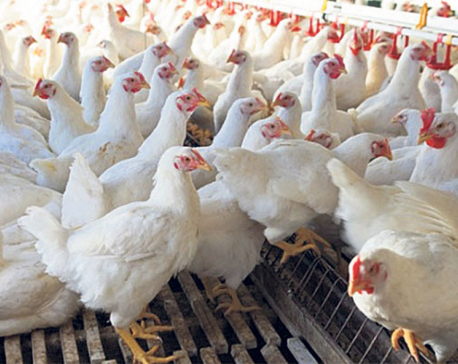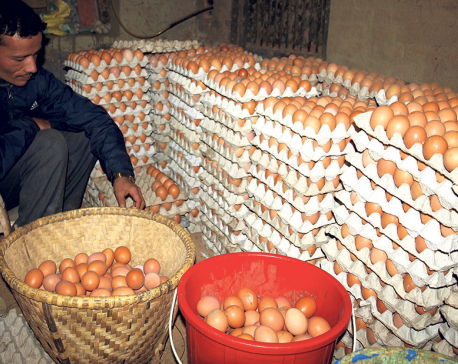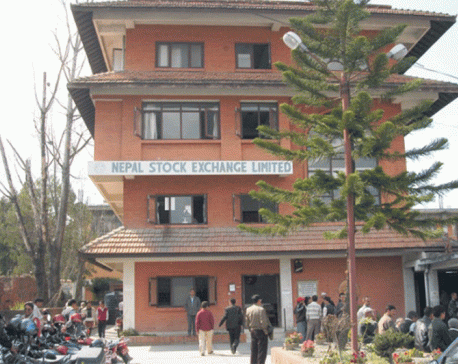
OR
Chick price soars to the dismay of poultry farmers
Published On: November 20, 2017 03:30 AM NPT By: Madhusudhan Guragain
BANEPA, Nov 20: The cost of chicks in the market has reached its peak in the decade with Rs 100 per chick since mid-November this year.
“The swell in unit price of chicks is the highest ever. The unit price was set at Rs 55 by hatcheries three years ago. This increased to Rs 75 and Rs 80 followed by Rs 100 now over the past three years,” said Dayaram Mahat, General Secretary of Nepal Chicken Sellers Association. Mahat added: “However, the price has now been unaffordable high for the farmers now which could discourage farmers from poultry farming.” Even when the price for chicks was settled between Rs 55 and 65 in August 2015, there had been a shortage of chicks for months, the rate constantly increased ever since.
The unit cost of chicks in FY 2016/17 hovered around Rs 60 to Rs 90. The constant fluctuation in the rate has brought the unit price of chicks to Rs 95 on which Rs 5 is added by the traders as profit.
“The fact that dealers in Terai have called several times insisting us to load chicks even if the price is a whooping Rs 90 suggests that there isn't surplus supply of boiler chicks in the hatcheries in Terai,” said Rajendra Thapa, who has been running Laxmi Poultry Farm and Hatchery.
Tikaram Pokhrel, President of Nepal Hatchery Association, told Republica that he has been awestricken by the condition of chick production and the sparing price of chicks in Nepal. “The rate for boiler chicks in Chitwan is Rs 85, a rate unlike any we have witnessed in the history of poultry farming in Nepal,” said Pokhrel.
Due to the decline of parent stock of hens in Nepal, chicks have been produced in fewer amounts. “The number of parent stock of hens remains low in India as well due to grand-parent organization VH Group's inability to import a new batch of Cobb-500 grandparents.
New hens could not be imported as India has restricted the import of hens from America due to bird flu,” said Pokhrel. “VH group has only been able to supply 60 percent of the demand for parent chicks. This has caused the price of chicks to rise in both Nepal and India.”
The situation of poultry farming has improved greatly since 2013. Nepal had to import Cobb-500 parents then, however new the parents can now be produced in Nepal itself from grand-parent chicks imported from USA.
Cobb Nepal Pvt. Ltd had imported grandparent chicks with an aim to supply at least 50 percent of the demanded parent chicks. However as this target could not be met, Nepalese hatcheries are having to import parent chicks from as far as Thailand, Malaysia, Sri Lanka and New Zealand. This issue is promptly addressed by Nepal Hatchery Management Association through technical assistance from the grandparent company in USA.
Although the world has a plethora of chicken types, Nepal has been producing only boiler (for meat) and layers (for eggs) chicks. Poultry farming has attracted those returning from foreign employment as yield can be obtained in just 4o days. “Currently, live boiler chicken go in around Rs 210 per kilogram. Farmers with 1000 boilers can easily bank Rs 150,000 worth of profit in a month. This has been a major cause of the increase in demand for chicks in the market,” says Jitendra Narayan Shrestha, who runs G&N Agritech in Banepa.
According to the statistics published by the Hatchery Association, currently, only 2 million to 2.2 million chicks are being produced every week despite the expectation of 6 million chicks a week.
You May Like This

Suppliers in Chitwan ‘cheat’ poultry farmers on weight
CHITWAN, May 13: Farmers of Chitwan have found that they have been cheated by suppliers when selling chicken. ... Read More...

Poultry farmers shift to other professions as shortage of chicks lingers
BANEPA, August 27: Poultry farmers in Kavre have been facing shortage of layers chicks. Bachhuram Thapa of Setidevi Poultry Farm at... Read More...

Nepse soars by two digits
KATHMANDU, Jan 1: The domestic share market that had been in a continuous fall in earlier days increased by two... Read More...











Just In
- Challenges Confronting the New Coalition
- NRB introduces cautiously flexible measures to address ongoing slowdown in various economic sectors
- Forced Covid-19 cremations: is it too late for redemption?
- NRB to provide collateral-free loans to foreign employment seekers
- NEB to publish Grade 12 results next week
- Body handover begins; Relatives remain dissatisfied with insurance, compensation amount
- NC defers its plan to join Koshi govt
- NRB to review microfinance loan interest rate







Leave A Comment